

| Our first China experience: Beijing | |
Beijing (China), September 25th 2010 |
|
This article is written by Franka and Jan, the parents of Ivonne We departed on September 22nd 2010 at 4 pm for our journey to Beijing in China to accompany our daughter Ivonne and her husband Edwin for two and a half months on their long journey. The start was in Beijing, and afterwards we plan to visit Tibet, Nepal and the northern part of India. After a stop in Dubai and a change to a different airplane, the pilot told us that we would cross the Himalayan Range at around seven o’clock in the morning. It was indeed a great experience to see this huge mountain range from above. On September 23rd at around three in the afternoon, we arrived at Beijing Capital International Airport were Ivonne and Edwin were waiting for us. It was great to see them again after almost a year. After a cup of coffee, we took the metro the city centre of Beijing. The difference with Bangkok in Thailand, were we started our previous journey with Ivonne and Edwin last year was big. In Thailand, people are waiting until the other passengers left the train, before entering the train themselves. But not here in China! As soon as the doors open, the Chinese try to get in as fast as possible without giving other passengers the chance to leave the train comfortably. Also on the streets, the difference is visible. The Chinese people walk their route as planned (shortest way) and don’t mind bumping into other people once in a while. When we arrived at our hostel near the Tianmen Square, we booked already the tour to the Great Wall, which we planned to visit a couple of days later. Ivonne and Edwin did this tour already some months ago, but at that time the name of the tour was still the “Secret Wall Tour” in stead of the “Ancient Wall Tour”. It seems that somewhere in the previous two months, a part of the non-restored wall is closed because of security reasons. It was too dangerous because of the slippery paths to go there. But the receptionist of the hostel guaranteed us that it was still possible to visit some parts of the non-restored wall and that this part of the wall is still seldom visited. So we decided to book the tour. Afterwards it was time to eat our first meal in China. We decided to go to a typical Chinese restaurant where we ordered Peking Duck. Of course, to be eaten with chopsticks. Only after receiving the compliments from Ivonne and Edwin about the way we handled the chopsticks, we confessed that we did some practising before at home. |
|
 |
|
A difficult hike on an unrestored part of the Great Wall |
|
The next day, we started the day with a visit to the Tianmen Square. Before entering the square, we had to put our daypacks through the x-ray machine. Later, it seemed that every visit to a sight in Beijing or a ride with the metro meant going through a similar security procedure. The Tianmen square was very crowded. For many Chinese people it is a dream to visit the square at least once during their life. The portrait of Mao was clearly visible on the gate that leads to the Forbidden City. There were also a lot of military people present on the square standing in a formal position, keeping an eye on the visitors. The big screens showing propaganda movies about the beauty of China were a little bit overdone in our opinion. After our visit to the square we walked through the Forbidden City, which was impressive to visit, to the Drum and Bell Tower. On the way, we also visited some old Hutongs, small typical Chinese alleys that are becoming rarer these days. Especially during the developments as preparation for the 2008 Olympic Games, many Hutongs are destroyed to make space for new developed areas. At the Drum Tower, we took a steep flight of stairs to the top of the building. There were a lot of huge drums with the size of approximately 2.2 metres long and a diameter of around 1.8 metres. A group of men in traditional clothes gave a demonstration about how the drums were used in previous times. We also visited the Bell Tower, where we also had to climb to the top. There was a huge clock present and we think that people used to throw coins against the bell to hear the sound of the bell. But that wasn’t allowed anymore. A sign with the text “no coins against the bell” made this clear. The next day we took the tour to the Great Wall. We joined the tour with only eight other people and that were all the people present on the stretch of wall that we visited that day. During the ride to the wall, which took around two and a half hours for 75 kilometres, we also saw the more visited part of the wall like Badaling. Thousands of people visit these parts of the wall, but we were happy that we decided to go to a part of the wall that we had all for ourselves. When we arrived, the guide of our small group told us that we could walk to the 6th tower and that we had to turn there. In total, we got three hours to make this beautiful hike. The first part of the hike was over restored parts of the wall, but halfway, the wall wasn’t restored anymore. It made hiking more difficult, because of the loose stones and grass and other scrub that grew over the wall. We lost lots of fluids in the form of sweat. Some parts of the wall were very steep with high steps. We were wondering how hard it must have been for the people who constructed this wall so many years ago, without any modern equipment. They had to carry all the big stones over these inhospitable mountains to construct this wall. It was special to walk over this historical masterpiece. |
|
 |
|
Jan on the picture with a Chinese lady |
|
| The day after, we visited to the Summer Palace. This restored palace including the extensive gardens is a pleasant place to spend a day. However, it isn’t really authentic anymore and partly because of the huge number of people, it has some kind of a theme park atmosphere. On the way back, we brought a visit to the Junshan Park. And that was a surprise. It was at the end of the day and many Chinese people came to the park to play music and sing traditional Chinese songs. The atmosphere was great! Afterwards we climbed to small hill in the park to have a view on Beijing by night. Unfortunately, the Forbidden City wasn’t beautiful lit, but it was still a great place to see the sun going down over this immense city. While enjoying the view, we still heard the music and singing coming from the park at the foot of the hill. On the way back to our hostel we passed the Tianmen Square where we made some evening pictures and films of the Mao portrait. And we were not the only ones. Hundreds of Chinese did the same. The morning after we checked out and put our luggage in the luggage room of the hostel. That evening we took the train to Lhasa in Tibet, but we first had one more day to spend in Beijing. We decided to visit the Olympic Park.
We were very curious about the water cube (swim stadium) and the bird nest (Olympic Stadium). We saw them many times on TV before, but not in real. We went into the bird nest stadium, and it was very impressive. We saw the water cube only from the outside. We were happy that we visited these stadiums as the last highlight of our visit to Beijing. In the afternoon we went back to the hostel to pick up our luggage and took the very crowded city bus number 67 to the Beijing-Xi (Beijing West) train station. With the train, which took around 48 hours, we travelled over a pass of more than 5100 metres to the capital of Tibet; Lhasa. © copyright - Babakoto.eu / 2010 |
|